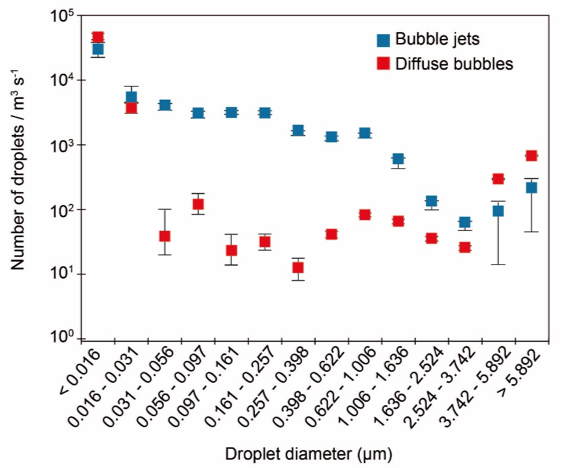Experimentally probing the origin of Enceladus’s plume: bubble-bursting and aerosol formation at the liquid/vapour interface
- AstrobiologyOU, The Open University, Milton Keynes, UK
Introduction. The Cassini spacecraft’s encounters with ice grains within the plumes of Enceladus have implied that they originate as droplets of ocean fluid (aerosols), produced by vigorous bubbling at the liquid-vapour interface [1],[2]. Seawater aerosols on Earth, also formed through bubble-bursting, exhibit strong size-dependent differences in their composition and organic content [3],[4]. Compositionally distinct populations of grains detected by Cassini suggest that analogous processes may operate to segregate ocean constituents within the plumes [1]. We used a purpose-built experimental plume aerosol facility to investigate the size-dependent flux and composition of aerosols produced via bubble-bursting under conditions relevant to Enceladus. Our findings show how rates of volatile exsolution influence aerosol size distributions, revealing mechanisms that shape plume stratification. Ongoing work is establishing the efficiency of transfer of organic compounds into aerosols under biological and non-biological scenarios, and how this varies across size fractions relevant to the ice grain profiles encountered by Cassini.
Methods. Plume simulation facilities. Aerosols are generated in a temperature-controlled reaction vessel that holds between 5 and 40 litres of fluid, through which mixes of gases are bubbled (Fig. 1). Fluid and gas compositions can be adjusted to simulate any desired chemical conditions. Gas flow rates and bubble injection dynamics can be varied between endmember states of small diffuse bubbles, representative of steady exsolution of volatiles, and vigorous jets of large bubbles, representative of violent boiling. Aerosols are fed into the inlet of a Dekati ELPI+ cascade impactor with real-time enumeration via a gas stream. Particle numbers and size distributions are recorded per second. Aerosols are physically separated into 14 size fractions with diameters between 0.01 and 10 µm and collected onto polycarbonate or aluminium foils, which are then recovered for downstream analyses.
Experimental approach. We conducted experiments using both simple NaCl fluids, and fluids designed to fully simulate Enceladus ocean chemistry [5]. To investigate endmember ‘controlled boiling’ scenarios [6], bubble injection dynamics were altered between diffuse and violent bubble jets, while absolute gas flow rate was maintained at 14.2 litres s-1 m-2 of surface area. Aerosol size distributions were monitored for 25 minutes. In ongoing work, collected aerosols fractions are recovered and analysed for their inorganic and organic composition and biomass content, and compared across biological and non-biological simulations. Extracellular polysaccharides produced by the facultative anaerobic bacterium Halomonas ventosae [7] are used as a biological analogue of the insoluble organic layer inferred to exist at the surface of the liquid reservoir at Enceladus [1]. This allows us to investigate how the presence of such a layer affects the flux and size-dependent organic content of aerosols.
Results and discussion. Our preliminary data show that contrasting bubble dynamics can result in dramatically different aerosol profiles (Fig. 2). Both bubbling styles led to the production of high numbers of extremely small (< 0.031 µm) particles. In the peak size range of ice grains encountered by Cassini (1 – 4 µm), bubbling styles produced aerosols with similar efficiencies [8]. However, between 0.031 and 1.006 µm aerosols produced by violent bubble jets exceeded those produced by diffuse bubbling by at least an order of magnitude. Because Cassini did not encounter high numbers of such particle sizes, this finding suggests that diffuse bubbling is a more likely plume origin, or that some other process within the plumes efficiently removes particles in this size range.
Our experiments provide new insights into the size-dependent flux of aerosols produced at the liquid/vapour interface at Enceladus, and how this ultimately defines the composition of ice-grains ejected to the altitude of spacecraft fly-throughs. Ongoing work is investigating the efficiency of transfer of organics into plume aerosols under biological and non-biological scenarios. Findings will enable new insights into Cassini plume fly-through data and can be leveraged to predict plume behaviour and composition at other planetary bodies with active plumes, such as Europa.
References. [1] Postberg F, et al. Nature. (2018) 558(7711):564-568; [2] Porco CC, et al. Astrobiology (2017) 17(9):876-901; [3] Salter ME, et al. Geophys Res Lett. (2016) 43(15):8277-8285; [4] Rastelli E, et al. Sci Reports (2017) 7(1):1-10; [5] Fox‐Powell MG, Cousins CR. J. Geophys Res. Planets. (2021) doi:10.1029/2020je006628; [6] Ingersoll AP, Nakajima M. Icarus (2016) 272:319-326; [7] Mata JA, et al. Res Microbiol (2006) 157(9):827-835; [8] Spahn F, et al. Science (2006) 311(5766):1416-1418

Figure 1. Schematic of experimental plume aerosol facility.

Figure 2. Aerosol size distributions recorded over 25-minute experimental runs. Data points represent median values, error bars indicate minimum and maximum counts.
How to cite: Fox-Powell, M., Slade, D., Siggs, D., and Olsson-Francis, K.: Experimentally probing the origin of Enceladus’s plume: bubble-bursting and aerosol formation at the liquid/vapour interface , Europlanet Science Congress 2022, Granada, Spain, 18–23 Sep 2022, EPSC2022-1231, https://doi.org/10.5194/epsc2022-1231, 2022.

